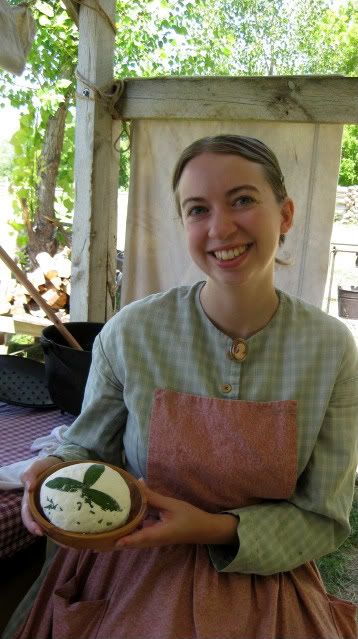Pour into boiling milk as much vinegar or lemon-juice as will make a small quantity quite clear, dilute with hot water to an agreeable smart acid, and put a bit or two of sugar. This is less heating than if made of wine; and if only to excite perspiration, answers as well.
~Rundell, Maria Eliza Ketelby. A New System Of Domestic Cookery, Formed Upon Principles Of Economy, And Adapted To The Use Of Private Families. By A Lady. Boston: W. Andrews, 1807.
So far, rennet is not working out for me in the cheese department. Maybe it makes you nervous too, but you want to make cheese. This is the cheese for you!
This kind of cheese does not melt or act like normal cheese, so I like to crumble it up with salt (LOTS of salt) and chives and eat it on crackers. You can also use it as a meat substitute. This is also the kind of cheese Indians call Panir and Mexicans call Queso Blanco. Or you can use it like ricotta.
1. Heat 1 gallon of milk to 185 F.

Stir pretty much constantly. Milk tends to burn on the bottom, which will make your cheese taste like burning. That is bad. It also forms a skin on top, under which pressure builds until it suddenly boils right over the top of your pot and burns onto your stove. If doing this over a fire, it helps to have a friggin' huge spoon.
 2. Take off the heat and add 1/4 C. vinegar or lemon juice. Stir until the curds separate from the whey. It should take about 10 seconds. The whey will be almost clear. You can throw it away or use it to make breads and things, as the whey has lots of vitamins and whatnot.
2. Take off the heat and add 1/4 C. vinegar or lemon juice. Stir until the curds separate from the whey. It should take about 10 seconds. The whey will be almost clear. You can throw it away or use it to make breads and things, as the whey has lots of vitamins and whatnot.
 3. Pour into a dish towel. Cheesecloth will not work here because the curds are very small, unless you have several layers. If you squeeze it, it will turn into a sliceable ball, as I did. If you just pour it in and then let it hang naturally, it will be like little crumbles. Hang it up to drip dry for a while. At home, I find the faucet over the sink works well for this.
3. Pour into a dish towel. Cheesecloth will not work here because the curds are very small, unless you have several layers. If you squeeze it, it will turn into a sliceable ball, as I did. If you just pour it in and then let it hang naturally, it will be like little crumbles. Hang it up to drip dry for a while. At home, I find the faucet over the sink works well for this.
 4. Ta da! A cheese! You can either mash it up into crumbles, or refrigerate and slice.
4. Ta da! A cheese! You can either mash it up into crumbles, or refrigerate and slice.
 If you add herbs, it is even more tasty! My favorite is sage.
If you add herbs, it is even more tasty! My favorite is sage.

SAGE CHEESE. --Take some of the young top leaves of the sage plant, and pound them in a mortar till you have extracted the juice. Put the juice into a bowl, wipe out the mortar, put in some spinach leaves, and pound them till you have an equal quantity of spinach juice. Mix the two juices together, and stir them into the warm milk immediately after you have put in the rennet. You may use sage juice alone; but the spinach will greatly improve the colour; besides correcting the bitterness of the sage.
~Leslie, Eliza. Directions for Cookery, in its Various Branches. Philadelphia: E.L. Carey & Hart, 1840.

6 comments:
What a beautiful cheesemaker you are and a simply perfect cheese...over a fire ??? Amazing... Now you will fovever walk on water !
BRAVO Jana !!!
Awww, thanks! I am glad I have recovered some of my honor. ;D
I am quite impressed with your really big spoon.
It is a very well-crafted giant spoon, yes?
Can you use goats milk as while.
I don't see why not.
Post a Comment